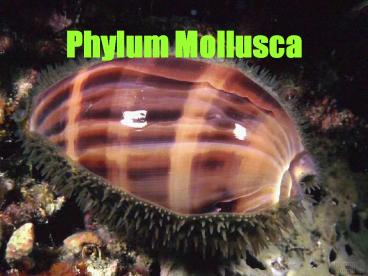Phylum Mollusca - PowerPoint PPT Presentation
1 / 23
Title:
Phylum Mollusca
Description:
However, most have a hard internal or external shell. ... Yellow nudibranch. Flame scallop. Flamingo tongue cowrie. Atlantic squid. Snail slug ... – PowerPoint PPT presentation
Number of Views:184
Avg rating:3.0/5.0
Title: Phylum Mollusca
1
Phylum Mollusca
2
General Information
- More than 112,000 species!!!!!!!
- Literally means soft body
- However, most have a hard internal or external
shell. - Some are sedimentary filter feeders while others
are predators with complex nervous systems. - Bilateral symmetry
- Examples
- Snails, conchs, slugs, clams, oysters,
- squid, octopus.
3
Mollusks are Coelomates
- A hollow cavity surrounded by mesoderm.
- Body wall muscles are separated from the gut
muscles. - This gives mollusks an advantage
- They are able to contract the body wall muscles
without hindering the movement of food through
the gut.
4
Coelomates Contd.
- This also provides a space for transporting blood
without any interference from other internal
organs.
5
All Mollusks Share The Feature Of
- Trochophore larva.
- Usually free swimming.
- Cilia on the surface of the larva propel it
through the water and assist in drawing food in. - They are carried in ocean currents and tides.
- This contributes to species dispersal.
- Mollusks share the feature of a trochophore larva
with annelids.
6
Trochophore larva
7
Mollusk Body Plan
- Consists of two regions
- Head-foot
- Visceral Mass
- Head-Foot
- Head mouth and a variety of sensory organs.
- Foot large, muscular organ used for locomotion.
8
Body Plan Contd
- Visceral Mass
- Heart, digestive, excretory, and reproductive
systems. - Protected by the mantle (outer layer of
epidermis). - This mantle secretes 1 to 2 hard shells of
calcium carbonate. - Gills were adapted to overcome this and a mantle
cavity protects them. - The mantle cavity is the space between the mantle
and the visceral mass.
9
(No Transcript)
10
Nervous System
- Ganglia paired clusters of nerve cells
connected by 2 pairs of long nerve cords which
control muscles responsible for movement and
feeding. - Found in both the head-foot region and the
visceral mass. - They also control sensory cells that respond to
light, touch, and chemicals.
11
The class Cephalopoda has the most advanced
nervous system of any invertebrate.
12
Feeding
- Radula
- Feeding adaptation
- Flexible, tongue-like strip of tissue covered
with tough, abrasive teeth that point backward. - Terrestrial mollusks use them to scrape leaves.
- Aquatic mollusks use them to scrape algae or
drill holes in the shells of other mollusks. - Some marine mollusks use radula like a harpoon
that inject venom.
13
Radula
14
Common chiton
15
Blue ringed octopus
16
Chambered nautilus
17
Giant clam
18
Yellow nudibranch
19
Flame scallop
20
Flamingo tongue cowrie
21
Atlantic squid
22
(No Transcript)
23
Snail slug































